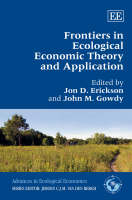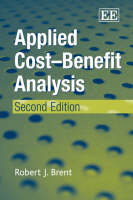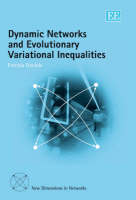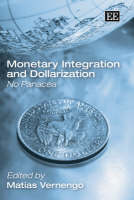Economics of Environmental Conservation, Second Edition
 -15%
portes grátis
-15%
portes grátis
Economics of Environmental Conservation, Second Edition
Tisdell, Clement A.
Edward Elgar Publishing Ltd
10/2005
320
Dura
Inglês
9781843766148
15 a 20 dias
LIST OF MOST SIGNIFICANT CHANGES IN CLEM TISDELL'S
SECOND EDITION OF ECONOMICS OF ENVIRONMENTAL CONSERVATION COMPARED TO 1ST EDITION ORGANISED BY CHAPTERS
Chapter 1
Contains a new section on "Uncertainty, welfare and environmental issues".
Chapter 2
Has been renamed "Global conservation strategies and concerns" updated, and a new section added: "Significant differences between Caring for the Earth and the World Conservation Strateg."
Chapter 3
* A slight alteration of chapter title has been made so that it now reads: "Markets and government intervention in environmental conservation".
* A new introductory section has been added in order to place the market system within a set of social mechanisms for environmental management. This enables market mechanisms to be seen in context. Also in this new section the possibility of using market mechanisms for resource management is related to property rights and the scope for excludability on the one hand, and rivalry or competitiveness in the use of resources on the other. This is important because it specifies (classifies) the prospects for using markets to efficiently manage environmental resources.
* New material is added to provide a simplified exposition of the theory of Paretian relevant and irrelevant environmental externalities.
* Tradeable environmental rights are added as one mechanism for managing adverse environmental externalities.
Chapter 4
* Additional illustrations and examples of issues involving environmental conservation in developing countries have been put in the text.
* A final section is added to provide concluding observations on conservation in LDCs.
Chapter 5
Several new sections have been added to this chapter to take account of advances in theory and changed world conditions since the 1st edition eg. the development of the total economic value concept the use of GMOs and growing globalisation. Added sections cover the following:
* Total economic value and the valuation of wildlife and biodiversity;
* Property rights in genetic material, GMOs, and conservation of biodiversity; and
* Globalisation, market extension and genetic diversity of domesticated animals and plants.
Chapter 6
* The title has been slightly changed and a clearer distinction has been made between open-access resources and communal resources.
* There are links back to the property rights discussion in the first section of Chapter 3.
* An extra section has been added to clarify and discuss open-access to resources and its regulation.
Chapter 7
The title of this chapter has been altered somewhat to better reflect its contents. It is now entitled "Economics of conserving natural resources and valuation techniques." Several extra sections are added, these include:
* "An overview of approaches to estimating the value of non-marketed commodities". This places the various economic valuation techniques in context.
* "Some additional economic valuation techniques". This introduces choice modelling and mixed techniques, such as the hedonic travel cost method.
* "Using total economic values for social choices about resource use." This provides a further opportunity to put economic valuation techniques in context and to follow-up the use of the total economic valuation technique introduced in Chapter 5.
* "Government versus non-government provision of natural areas". Since the 1st edition, NGOs have become increasingly involved in conservation and this section is added to assess their economic role and the rationale of their involvement.
Chapter 8
A new section has been added:
"Forest plantations versus natural forests: a discussion". This addresses an important environmental issue.
Chapter 9
A new section has been added entitled "Genetically modified organisms in agriculture: economic and biodiversity issues". This has been done to keep the chapter on agriculture and the environment abreast of new developments.
Chapter 10
Two sections have been added:
* "Tourism, conservation and the total economic value of a natural area and economic impact and economic impact analysis". This enables the practical implications of two different sets of economic concepts to be appreciated and provides cross links to sections in Chapters 5 and 7.
* "Sustainability, ecotourism and economics". This discusses the nature of ecotourism, its economics and whether or not it contributes to sustainability.
Chapter 11
A new section has been added entitled "Capital, natural resource conversion and human welfare: further considerations". This provides an opportunity to relate natural resources to conceptual developments in the theory of capital and provides a more in depth treatment of strong and weak conditions for sustainable development.
Chapter 12
This chapter has undergone significant change. Its title is altered to "Population, economic growth, globalisation and conservation: a concluding perspective". The sections on population levels and population growth have been revised and updated. The following new sections are added:
* "Environmental Kuznets curves: do they provide grounds for environmental optimism?" The concept of the environmental Kuznets curve was not in the literature when the 1st edition was produced.
* "Is economic globalisation favourable or unfavourable to environmental conservation?" Since the first edition, economic globalisation has increased in importance and the above issue has been hotly debated. Ecological economics provides some important perspectives on it.
* The "Concluding remarks" section has been rewritten so as to reflect the major changes in this chapter.
Apart from the above, changes have been made in most of the retained sections from the 1st edition (of which only a few have been deleted). For example, to update materials, extra references have been added. However, the essential features of the 1st edition have been retained and no important material from the 1st edition has been discarded. A critically constructive approach is retained.
Clem Tisdell
8 February 2005
LIST OF MOST SIGNIFICANT CHANGES IN CLEM TISDELL'S
SECOND EDITION OF ECONOMICS OF ENVIRONMENTAL CONSERVATION COMPARED TO 1ST EDITION ORGANISED BY CHAPTERS
Chapter 1
Contains a new section on "Uncertainty, welfare and environmental issues".
Chapter 2
Has been renamed "Global conservation strategies and concerns" updated, and a new section added: "Significant differences between Caring for the Earth and the World Conservation Strateg."
Chapter 3
* A slight alteration of chapter title has been made so that it now reads: "Markets and government intervention in environmental conservation".
* A new introductory section has been added in order to place the market system within a set of social mechanisms for environmental management. This enables market mechanisms to be seen in context. Also in this new section the possibility of using market mechanisms for resource management is related to property rights and the scope for excludability on the one hand, and rivalry or competitiveness in the use of resources on the other. This is important because it specifies (classifies) the prospects for using markets to efficiently manage environmental resources.
* New material is added to provide a simplified exposition of the theory of Paretian relevant and irrelevant environmental externalities.
* Tradeable environmental rights are added as one mechanism for managing adverse environmental externalities.
Chapter 4
* Additional illustrations and examples of issues involving environmental conservation in developing countries have been put in the text.
* A final section is added to provide concluding observations on conservation in LDCs.
Chapter 5
Several new sections have been added to this chapter to take account of advances in theory and changed world conditions since the 1st edition eg. the development of the total economic value concept the use of GMOs and growing globalisation. Added sections cover the following:
* Total economic value and the valuation of wildlife and biodiversity;
* Property rights in genetic material, GMOs, and conservation of biodiversity; and
* Globalisation, market extension and genetic diversity of domesticated animals and plants.
Chapter 6
* The title has been slightly changed and a clearer distinction has been made between open-access resources and communal resources.
* There are links back to the property rights discussion in the first section of Chapter 3.
* An extra section has been added to clarify and discuss open-access to resources and its regulation.
Chapter 7
The title of this chapter has been altered somewhat to better reflect its contents. It is now entitled "Economics of conserving natural resources and valuation techniques." Several extra sections are added, these include:
* "An overview of approaches to estimating the value of non-marketed commodities". This places the various economic valuation techniques in context.
* "Some additional economic valuation techniques". This introduces choice modelling and mixed techniques, such as the hedonic travel cost method.
* "Using total economic values for social choices about resource use." This provides a further opportunity to put economic valuation techniques in context and to follow-up the use of the total economic valuation technique introduced in Chapter 5.
* "Government versus non-government provision of natural areas". Since the 1st edition, NGOs have become increasingly involved in conservation and this section is added to assess their economic role and the rationale of their involvement.
Chapter 8
A new section has been added:
"Forest plantations versus natural forests: a discussion". This addresses an important environmental issue.
Chapter 9
A new section has been added entitled "Genetically modified organisms in agriculture: economic and biodiversity issues". This has been done to keep the chapter on agriculture and the environment abreast of new developments.
Chapter 10
Two sections have been added:
* "Tourism, conservation and the total economic value of a natural area and economic impact and economic impact analysis". This enables the practical implications of two different sets of economic concepts to be appreciated and provides cross links to sections in Chapters 5 and 7.
* "Sustainability, ecotourism and economics". This discusses the nature of ecotourism, its economics and whether or not it contributes to sustainability.
Chapter 11
A new section has been added entitled "Capital, natural resource conversion and human welfare: further considerations". This provides an opportunity to relate natural resources to conceptual developments in the theory of capital and provides a more in depth treatment of strong and weak conditions for sustainable development.
Chapter 12
This chapter has undergone significant change. Its title is altered to "Population, economic growth, globalisation and conservation: a concluding perspective". The sections on population levels and population growth have been revised and updated. The following new sections are added:
* "Environmental Kuznets curves: do they provide grounds for environmental optimism?" The concept of the environmental Kuznets curve was not in the literature when the 1st edition was produced.
* "Is economic globalisation favourable or unfavourable to environmental conservation?" Since the first edition, economic globalisation has increased in importance and the above issue has been hotly debated. Ecological economics provides some important perspectives on it.
* The "Concluding remarks" section has been rewritten so as to reflect the major changes in this chapter.
Apart from the above, changes have been made in most of the retained sections from the 1st edition (of which only a few have been deleted). For example, to update materials, extra references have been added. However, the essential features of the 1st edition have been retained and no important material from the 1st edition has been discarded. A critically constructive approach is retained.
Clem Tisdell
8 February 2005











